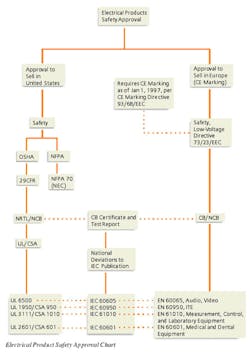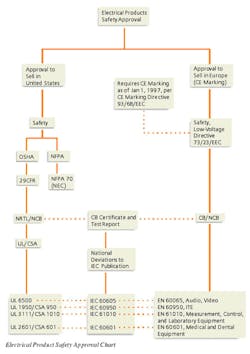Product safety seems like a very straightforward concept—a product should cause no harm. But if you want to sell products in many markets around the world, the concept can become complicated as you try to meet the safety requirements of individual countries.
For electrical product safety standards in the United States and Canada, most people are familiar with Underwriter Laboratories (UL) and the Canadian Standards Association (CSA). The UL safety standard that applies to information technology equipment (ITE), for example, is UL1950. A similar CSA standard is CSA950. In this instance, a binational standard, UL1950/CSA950, exists.
Standards governing electrical products sold in Europe are set up differently. The European Union (EU) has established European Economic Community (EEC) directives. The directive that applies to most electrical products for safety is the Low-Voltage Directive (LVD) or 73/23/EEC. The LVD mandates the CE Marking, a requirement for selling your products in Europe. Furthermore, 73/23/EEC calls out harmonized European Norm (EN) standards for each product grouping, such as EN 60950 for ITE.
The CB Scheme
Consider the situation that existed a year ago. Manufacturers had to obtain national safety approvals for every country they sold their product in, according to Robert Loop, manager of product safety at Wyle Laboratories. This was a time-consuming and expensive process, he said.
Matters were further complicated by language barriers and different test requirements for each country. And, it was not likely that any country would abdicate the right to control products sold within its borders.
A solution to this process was realized through what became known as the Certified Body (CB) scheme. According to Jolanta Wroblewska, corporate CB scheme coordinator at UL, the International Electrotechnical Committee for Conformity Testing to Standards for Electrical Equipment (IECEE) CB scheme is a global network of National Certification Bodies (NCBs) that has agreed to mutual acceptance of CB test certificates and reports.
The CB scheme applies to many specific product categories established by the IECEE. It requires that national standards be harmonized with the corresponding International Electrotechnical Commission (IEC) publication. For example, the publication for ITE is IEC 60950. The IECEE must accredit each NCB to participate in each of its particular product categories.
A great deal of information is available on global certifications. For example, many web sites address issues regarding the CB scheme. Participating NCBs, countries, and product categories can be reached at http://www.cbscheme.org and http://www.cbscheme.com.
NCB Selection
Your task is to find an NCB, make sure your product passes the appropriate IEC tests, and have the NCB issue a CB test certificate and test report. In the United States, the American Association for Laboratory Accreditation (A2LA), the National Institute of Standards and Technology (NIST), and the National Voluntary Laboratory Accreditation Program (NVLAP) can provide listings of accredited laboratories.
To find an NCB, start with the list of Nationally Recognized Testing Laboratories (NRTLs). You can apply to an NCB in any participating country, said Wyle’s Mr. Loop, but be sure that the NCB is approved for testing in the category of equipment you wish to have certified. Don’t just assume that all NCBs are certified in every equipment category.
To get the product approved for sale elsewhere, these certification documents are presented to an NCB with jurisdiction in the desired location. The destination NCB then takes over, advising what is necessary for approvals in nations that it is certified to serve. The goal is no retesting, but sometimes minimal retesting is required. As you meet the requirements of each nation, the destination NCB issues you a CB certificate for that country.
Product Safety Tests
Testing to many of the standards applicable to common products is similar, according to Joe Vogel, manager of product safety at Washington Laboratories. The standard test suite consists of:
- Temperature rise to see if any components attain temperatures high enough to melt insulation, produce a fire hazard, or burn users.
- Ground impedance tests, in which the resistance usually is required to be less than 0.1 W, to check the integrity of the path from accessible conductive parts to the protective earth of the supply connection.
- Dielectric strength, or hipot tests, to verify the integrity of the insulation in the equipment.
- Leakage current tests to measure the energy available on conductive parts that could create a shock hazard.
National Deviations
What differences in product safety requirements might you encounter when attempting to market your products in other countries? In most cases, these issues fall under the heading of national deviations.
Each participating country in the CB scheme must declare any national differences from the IEC publication, according to Kenneth Boyce, engineering manager at UL. The differences may vary widely depending on product type and location. The language of markings and the method of connection to AC power are important and recurrent differences.
A CB report, based on the relevant standard and which addresses the deviations of other nations, can be produced by the NCB, according to Mr. Vogel of Washington Labs. The report would be submitted to the NCBs in other marketing locations for review. The reviewing NCB may accept the report entirely or request a sample for a brief evaluation or to spot-check the test data. Upon acceptance of the test report, the reviewing NCB would issue the appropriate national certifications.
Conclusion
Thanks to the CB scheme, a network of NCBs is available to help you achieve electrical safety approval and market your products in 35 member nations around the world. Armed with this information, you can chart your course to multinational approval.
These companies provided information for this article:
|
TPEC/Tandem Product Evaluation Center |
(408) 285-2541 |
| Trace Laboratories-Central | (847) 934-5300 |
| Underwriters Laboratories | (847) 272-8800 |
| Washington Laboratories | (301) 417-0220 |
| Wyle Laboratories | (256) 837-4411 |
Subscribe Now | Return to Home Page
Article originally appeared in May 1999 issue of EE-Evaluation Engineering.
All contents © 1999 Nelson Publishing Inc.
May 1999

